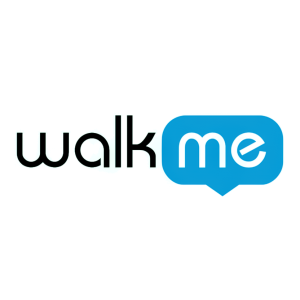Enterprises losing more than $1M a week through inefficient technology use, WalkMe report reveals
Investment in digital adoption technology rises
SAN FRANCISCO, Feb. 07, 2024 (GLOBE NEWSWIRE) -- WalkMe Ltd. (NASDAQ: WKME), a leading provider of digital adoption solutions, today released its flagship report, The State of Digital Adoption 2024 (SoDA 2024). The report shows that, while digital adoption is a rising priority for enterprises, a lack of best practice is still costing many organizations dearly1. The research, based on a survey of more than 4,000 executive and employee respondents, found that an inability to correctly and fully utilize technology costs enterprises on average
Prioritizing digital adoption has shown proven results for enterprises.
This success explains why
"SoDA 2024 is our most extensive report yet, highlighting the critical juncture at which we stand with global IT spend anticipated to reach
Highlights from the research:
- Employees spend as many as 353 hours, or 44 working days, a year compensating for technology issues such as troubleshooting software problems, waiting for support, or struggling with inadequate instructions.
- Enterprise leaders believe their organization uses 21 applications, but on average, large organizations use 211 applications while smaller companies use 69.
68% of organizations have a team of employees responsible for digital adoption across all departments — compared to48% in 2021.- Organizations that have embraced all digital adoption best practices save on average
$4.9M a month compared to those that only follow some. In addition, these enterprises see:14% less spend on digital transformation projects that fail to meet ROI.18% higher ROI from digital transformation projects.30% higher application utilization.- 21.5 working days a year of employees’ time saved through improved user experiences.
“As more organizations realize the need for effective change management and decide to fully embrace digital adoption, they will begin to experience HyperProductivity. In this aspirational state, everyone can use any application with ease, and companies will have automated as many processes as possible and integrated technologies into one cohesive, streamlined workflow,” continued Bloch. “By scaling and replicating digital adoption successes organization-wide, enterprises can give employees the tools, technology, and support they need to operate exponentially faster and more effectively than before. This will be crucial in navigating productivity challenges in an uncertain economic climate and ensuring organizations realize the full ROI of their projects.”
Download The State of Digital Adoption 2024 complete report here.
About WalkMe
WalkMe (WKME) pioneered the world’s leading Digital Adoption Platform (DAP) to drive enterprise productivity and reduce risk by ensuring consistent, responsible, and efficient adoption of software and the workflows it powers. Our AI-driven platform presides over an organization’s tech stack, identifies where people experience friction, and delivers the personalized guidance and automation needed to get the job done, right in the flow of work. Customers like IBM, Nestle, ThermoFisher Scientific, and the U.S. Dept. of Defense trust WalkMe to create people-centric experiences that maximize software ROI and deliver the visibility required to effectively navigate the constant change brought on by technology.
Special Note Regarding Forward-Looking Statements:
This press release contains forward-looking statements within the meaning of the Private Securities Litigation Reform Act of 1995. We intend such forward-looking statements to be covered by the safe harbor provisions for forward-looking statements contained in Section 27A of the Securities Act of 1933, as amended and Section 21E of the Securities Exchange Act of 1934, as amended. All statements contained in this press release other than statements of historical fact are forward-looking statements. The words “believe,” “may,” “will,” “estimate,” “potential,” “continue,” “anticipate,” “intend,” “expect,” “could,” “would,” “project,” “plan,” “target,” and similar expressions are intended to identify forward-looking statements, though not all forward-looking statements use these words or expressions. These forward-looking statements are subject to risks, uncertainties and assumptions, some of which are beyond our control. In addition, these forward-looking statements reflect our current views with respect to future events and are not a guarantee of future performance. Actual outcomes may differ materially from the information contained in the forward-looking statements as a result of a number of factors, including, without limitation, the following: our ability to manage our growth effectively, sustain our historical growth rate in the future or achieve or maintain profitability; the impact of the COVID-19 pandemic or adverse macro-economic changes on our business, financial condition and results of operations; the growth and expansion of the markets for our offerings and our ability to adapt and respond effectively to evolving market conditions; our estimates of, and future expectations regarding, our market opportunity; our ability to keep pace with technological and competitive developments and develop or otherwise introduce new products and solutions and enhancements to our existing offerings; our ability to maintain the interoperability of our offerings across devices, operating systems and third-party applications and to maintain and expand our relationships with third-party technology partners; the effects of increased competition in our target markets and our ability to compete effectively; our ability to attract and retain new customers and to expand within our existing customer base; the success of our sales and marketing operations, including our ability to realize efficiencies and reduce customer acquisition costs; the percentage of our remaining performance obligations that we expect to recognize as revenue; our ability to meet the service-level commitments under our customer agreements and the effects on our business if we are unable to do so; our relationships with, and dependence on, various third-party service providers; our dependence on our management team and other key employees; our ability to maintain and enhance awareness of our brand; our ability to offer high quality customer support; our ability to effectively develop and expand our marketing and sales capabilities; our ability to maintain the sales prices of our offerings and the effects of pricing fluctuations; the sustainability of, and fluctuations in, our gross margin; risks related to our international operations and our ability to expand our international business operations; the effects of currency exchange rate fluctuations on our results of operations; challenges and risks related to our sales to government entities; our ability to consummate acquisitions at our historical rate and at acceptable prices, to enter into other strategic transactions and relationships, and to manage the risks related to these transactions and arrangements; our ability to protect our proprietary technology, or to obtain, maintain, protect and enforce sufficiently broad intellectual property rights therein; our ability to maintain the security and availability of our platform, products and solutions; our ability to comply with current and future legislation and governmental regulations to which we are subject or may become subject in the future; changes in applicable tax law, the stability of effective tax rates and adverse outcomes resulting from examination of our income or other tax returns; risks related to political, economic and security conditions in Israel; the effects of unfavorable conditions in our industry or the global economy or reductions in information technology spending; factors that may affect the future trading prices of our ordinary shares; and other risk factors set forth in the section titled “Risk Factors” in our Annual Report on form 20-F filed with the Securities and Exchange Commission on March 14, 2023, and other documents filed with or furnished to the SEC. These statements reflect management’s current expectations regarding future events and operating performance and speak only as of the date of this press release. You should not put undue reliance on any forward-looking statements. Although we believe that the expectations reflected in the forward-looking statements are reasonable, we cannot guarantee that future results, levels of activity, performance and events and circumstances reflected in the forward-looking statements will be achieved or will occur. Except as required by applicable law, we undertake no obligation to update or revise publicly any forward-looking statements, whether as a result of new information, future events or otherwise, after the date on which the statements are made or to reflect the occurrence of unanticipated events.
Media Contact:
press@walkme.com
1 Surveys of 1,700 senior business leaders and 2,051 office and hybrid workers at enterprises in North America, Japan, APAC, UK & Ireland, France, DACH, Benelux and the Nordics.










